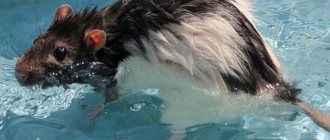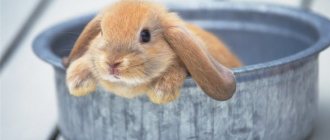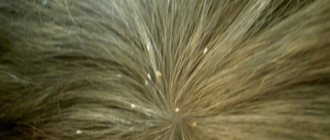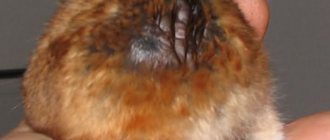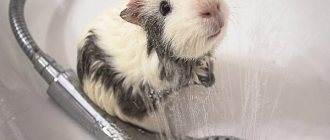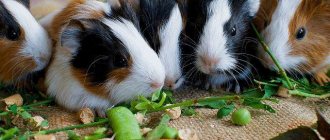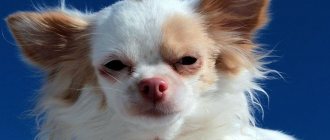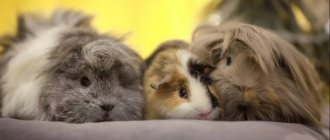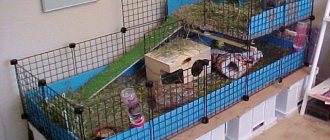How often can you wash your guinea pig?
Representatives of long-haired breeds are recommended to be bathed as rarely as possible, in particular:
- no more than once a month – in summer;
- Once every 2-3 months - in colder seasons.
It is permissible to wash short-haired pets twice a year - during spring and autumn molting, and for hairless (Skinny) breeds, on the contrary, regular hygiene is justified - every 1-2 months.
Small stains can be removed:
- a damp alcohol-free wipe – this is especially convenient for the paws;
- dry zoo shampoo.
More frequent water procedures are undesirable, even with the correct pet shampoo - contact with hard water negatively affects the condition of the skin and coat and can cause irritation.
Washing is also contraindicated:
under 6 months of age – bathing creates unnecessary stress and can lead to hypothermia. Moreover, the fur of the small rodent has not yet had time to become contaminated naturally. It is better to postpone the first bath until the age of one;
- in winter, due to the danger of drafts and cold;
- immediately after moving or purchasing - the animal is sensitive to changes in the environment, it needs at least a week to get used to it;
- for weakened or sick animals;
- during pregnancy.
You should not use force or bathe an animal that actively shows dissatisfaction, screams loudly or breaks out - it is better to get by with dry or partial hygiene.
Other ways to clean wool
If the animal is dirty and has been bathed recently, you can clean the fur by combing it thoroughly. Frequent water procedures can negatively affect the health of a guinea pig. If a rodent manages to get dirty after bathing, the next time you can take it to the bathroom no earlier than 3-4 weeks later.
If your guinea pig refuses to bathe in water or is unable to get used to the bathroom environment, you can use special sand for rodents. It is important to know that street sand is not suitable for swimming - it contains bacteria and parasites. Special sand purchased in a store is processed and disinfected and is completely safe for the health of the animal.
You can use a plastic container or deep plate to bathe your guinea pig in the sand. The animal must fit freely there.
If there are minor stains, they can be removed using wet wipes or cotton pads moistened with water. Wet wipes should be free of alcohol and fragrances.
How should pigs swim?
When it becomes clear that your pet loves to swim, you can build a mini-pond for him. The water temperature should be average, not hot, but not cold. Salt, flavorings, and especially chlorine should not be added to water. You should not leave your pet alone in a pond.
The guinea pig swims with pleasure, deftly moving its paws, usually for no more than 5 minutes. It is very interesting to watch this process. Then she gets tired.
A small animal can be gradually accustomed to water, thereby developing a love for bathing. Several times a week the pet is offered water treatments. If he is categorically against it, it means there is no predisposition to this, and there is no need to insist.
At their core, these animals are very clean and constantly clean their fur. They are very good at doing this on their own. For hygienic purposes, you can bathe them no more than once every 4–5 months. They also do this in cases where the pet has clearly gotten dirty in something and cannot cope with it on its own.
Guinea pigs are non-conflict and contact animals that can be kept at home. They are unpretentious in food, easy to care for and are friendly and playful towards humans. This article will discuss the popular types of these tame rodents, the origin of their name and the basic facts that all owners of sea or, as they are also called, Guinea pigs should know.
When are pigs washed?
In fact, furry rodents are clean animals and do not need bathing procedures. You should only bathe your guinea pig in cases where:
- the fur coat is excessively dirty;
- the animal has lost its presentation and looks unkempt;
- an unpleasant odor appeared;
- there are crusts and deposits in the sebaceous gland area;
- There will be an exhibition at which the animal should shine in all its splendor.
It is worth noting that if you follow the rules for keeping animals - systematically changing bedding, disinfecting a cage or terrarium - you can completely avoid water procedures throughout the animal’s life. At the same time, the absence of bathing will not bring any discomfort to the pet and certainly will not worsen the quality of life.
But there is another category of owners who are confident that washing guinea pigs is vital and the process cannot be ignored.
It is useless to argue on this topic. Both sides have plenty of arguments. Therefore, if you have an irresistible desire to bathe your pet, then you should not do this more often than once a month in the summer and once every two to three months in the winter.
Frequency of procedures
A reasonable question is how many times a month can you bathe a pig. If you have a long-haired pet, it seems that all he does is get dirty, get dusty, become covered in lumps of dirt, and so on.
Regular washing is not considered at all - for a mumps this is an unnatural procedure, so there is no schedule. If in the summer it is very hot, stuffy, and it seems to you that the pig wants to take a bath, then maximum once a month you can briefly give her a light shower. At other times, bathe your pig once every 3 months, not more often.
Frequent washing is dangerous for the animal. Both the water itself and especially the soap solution dry out the animal’s skin. Because of this, figuratively speaking, the pig’s immunity decreases. She becomes susceptible to various diseases.
Even a person can catch a cold after a bath, but a small animal, unaccustomed to its natural habitat, is under direct threat. Therefore, frequently bathing a rodent is strictly prohibited.
There are at least 5 more “don’ts” regarding bathing a guinea pig.
- You cannot bathe the cubs - only adults tolerate bathing procedures relatively calmly. A small guinea pig is threatened by stress from all sides, and it may not survive water stress. And young fur does not need to be washed.
- You should not bathe your pet in the first days at home. Many owners think that the first thing they need to do is bathe the pig so that it is “clean and fluffy” and gets accustomed better. On the contrary, such stress only interferes with the animal’s adaptation. Let him calmly get used to it, everything is new for him, everything is scary, everything is alien.
- Don't bathe your pet in winter. As already mentioned, a cold can be fatal for a rodent. Pigs are extremely sensitive to temperature changes and drafts.
- Do not place pregnant females in the water: bathing is extremely stressful for them and carries serious risks.
- Do not bathe a sick rodent.
Never break these rules - one case of neglect is enough to cause irreparable harm to the animal.
How to bathe a guinea pig at home
For swimming you will need:
- a basin of water;
- oil for hygiene procedures;
- cotton buds;
- suitable shampoo;
- napkins or soft toilet paper;
- towels;
- hairdryer
Shampoo for guinea pigs
A specialized shampoo for rabbits and guinea pigs or a shampoo for rodents is best. You can also use cat or baby shampoo. Do not use dog shampoo under any circumstances; it irritates the delicate skin of the animals. Don't forget about conditioner if your animal has long hair. Without it, combing long hair will be quite difficult.
Do you use a special shampoo for rodents?
How to properly wash a guinea pig
When the animal gets used to the bath, prepare a bowl of warm water in advance. The temperature should be 36-38 degrees. In colder water, your pig may catch a cold. It will be unpleasant for her in hot weather, and you will forever discourage her from swimming.
The water level should reach the tummy so that the pig can stand on its feet without its nose and mouth touching the water. Do not turn on the shower if you do not want to cause severe fright and attempts to escape. You can water your pig from a ladle, but do not raise it above head level.
It is better to warm the shampoo in your palm first so that it is not too cold. Lather the shampoo gradually, using soft stroking movements. Having a calm conversation with your pet will help her feel safe.
You can wash off the shampoo under running warm water. Rinse the coat thoroughly to ensure no clumps of shampoo remain in it. Dried shampoo irritates the skin. And the pig can eat it when it starts cleaning its fur itself. Her intestines are about two meters long, and any digestive problems are life-threatening.
When the shampoo is rinsed, you can apply a light combing conditioner and distribute it evenly over the entire length of the coat.
Some pigs don't like hair dryers
How to properly dry guinea pigs after bathing
Wrap your baby in a thick towel to absorb most of the water. In this case, the animal must be in a warm room. Dried but still slightly damp fur can be combed. For long-haired rodents, brushing at this stage is mandatory.
Final drying can be achieved using a hair dryer. To do this, turn on the flow of warm, not hot air. You need to dry in the direction of the wool, while lifting the hairs with your hand.
But not all overseas beauties like a hairdryer. Some are trying to panic and retreat from this roaring nightmare to the nearest secluded place. In this case, you can let the pig dry on a warm windowsill in the sun. A warm radiator covered with a thick towel is also suitable as a dryer. The main thing here is to make sure that the animal does not jump off or hit itself.
During the day after bathing, you should not open the windows so as not to catch a cold in your baby.
It is also important that the fur is completely dry before you put your pig in the cage, because otherwise pieces of litter, food grains and other debris can easily stick to it.
How to clean a guinea pig's ears
It is also recommended to clean the ears after bathing. Long hair often covers the auricle, preventing the animal from cleaning its ears on its own; as a result, wax constantly accumulates there. Over time, this leads to ear infections, inflammation of the middle ear and deafness. Therefore, all veterinarians agree that guinea pigs need to have their ears cleaned regularly.
If the pet reacts to the procedure too sharply - it breaks out, squeaks and tries to bite, this means that it is in pain, because the inflammatory process has already begun in the ear. In this case, you should consult a doctor, he will prescribe the necessary procedures and prescribe medications.
The procedure for cleaning your ears is quite simple:
- Free the ear from fur. If there are too many hairs and they are very long, they can be carefully cut off.
- Examine the ear and determine what needs to be done. Sulfur is easy to spot, it is the same color as the skin. Over time, the drying crusts darken.
- If there are no crusts, then chlorhexidine is used to clean the ears. They moisten a cotton swab or napkin with it to wipe the auricle.
- If there are a lot of crusts, they are dry and difficult to get, then you should first drip a special lotion into the ear, which is sold in veterinary pharmacies and pet stores. After some time, the crusts will soften and can be removed by wiping the ear with a napkin.
After all hygiene procedures, you should not forget about trimming the nails.
What should you not do after swimming?
- Taking your pet outside is prohibited for at least a day.
- Place the animal wet into a terrarium with sawdust or other filler.
- Leave the baby in a draft, on the floor, near an open window, in a cold room; otherwise, you cannot avoid catching a cold.
By the way, are there restrictions on the water procedures themselves?
- you cannot bathe a sick animal;
- Pregnant females and animals in a state of stress should not be subjected to water procedures;
- Also, you should not force wash those pigs that do not tolerate the procedure well and are very afraid. The panties are periodically wiped with damp wipes, using them to remove heavy dirt.
In fact, there are no specific rules for bathing, there are only general recommendations that should be followed. Each owner decides for himself how to wash, how many times and whether it is worth doing it at all, based on his own experience and intuition.
To wash or not to wash
Animal keepers are divided into two camps:
- Those who believe that guinea pigs should not be bathed.
- Proponents of washing rodents.
Arguments in favor of opponents of water procedures:
- Animals do not bathe in their natural habitat.
- The procedure disrupts the pH balance of the skin, exposing the animal to the risk of developing skin diseases (dandruff, fungus, etc.)
- Washing is stressful for the piglet, which negatively affects its health.
- There is a high probability of catching colds.
- Pigs are able to keep things clean on their own. Heavy food stains in the mouth and neck area will disappear on their own.
How to bathe a guinea pig at home
Bathing guinea pigs should take place in a warm room, reliably protected from drafts. Typically the bathroom is used for this. It’s better to first try to accustom the animal to new elements - bring him into the bathroom, let’s look around, open the tap so that he gets used to the sound of water. Accompany such visits with treats and petting. It is better to perform the washing procedure itself in several stages:
Pour enough warm water into a basin or sink. The level should be no higher than 3 cm - so that the pig can calmly stand on the bottom, keeping its muzzle above the surface. If this is the first bath, it is better to place a towel at the bottom of the container - a stable surface on which paws do not slip will reduce the pig’s stress.
The pet must be calmed before the procedure. Contact with water should not be a surprise or stress for him.
Therefore, hold him in your hands for a while, stroke his fur, and, if possible, let him examine and sniff the prepared bath and shampoo. If you have multiple guinea pigs, only wash them individually so you can have complete control over the process. Carefully place your pet in the water, holding it with your hand and stroking it. At this moment, you can offer the animal a tasty piece. Give your pet a few minutes to get comfortable and make sure nothing bad is happening.
If the animal begins to look around and move around, you can proceed to the next stage. Carefully hold the pig and pour water over it until all its fur is wet. Try to avoid getting water in the ears, nose and eyes - the hair on the head can be wetted simply by stroking it with wet fingers. Apply a little shampoo to the animal's back and begin to gently rub, spreading the foam over the body. There is no need to wash your head - the pig will wash its face itself when it cleans itself up after bathing.
Rinse off the shampoo - you can do this by holding your pig under a gentle stream of warm water. Make sure the coat is rinsed thoroughly - dried shampoo residue can cause irritation on sensitive skin.
Simultaneously with water procedures, it is better to clean the sebaceous gland and anal valve.
Anal valve hygiene
The gland is located on the back of the body; after steaming in warm water, it is generously lubricated with baby cream, and after a few minutes wiped with a damp cloth. After which you can carry out the procedure of washing the wool with shampoo. The anal valve is cleaned only when necessary - if it is noticeably dirty or has a specific smell
To clean, you need to press on the lower abdomen and carefully remove the contents of the pocket using a cotton swab dipped in oil. Then you can continue water procedures
Is it possible to swim?
When answering this question, it is important to consider two points:
- Under natural conditions, a rodent's coat is capable of self-cleaning. However, at home, new sources of pollution appear; shedding may increase due to diet or temperature conditions;
- In the wild, pigs are a land species, but can swim.
Conclusion - your pet does not urgently need regular bathing, but you can wash it if necessary. Among the direct “indications” for water procedures:
- the appearance of an unpleasant odor;
- parasitic infestations (on the recommendation of a veterinarian);
- dull hair without pathological reasons (more often in summer) - in such cases, the pig needs help to put itself in order;
- excessive shedding, tangles;
- severe contamination - for example, contact with sweet liquids, pieces of food or excrement on the fur;
- the need to wash off medicinal oil compositions;
- preparation for the exhibition;
- inflammation of the sebaceous glands or fecal pouch (in males) - in order to cleanse the skin of inflammatory secretions and crusts.
Rules for conducting water procedures
Washing guinea pigs is different from washing dogs and cats. If the rodent is undergoing the procedure for the first time, then 5-6 days before it you need to pick it up and go into the room where the bathing will take place. Simultaneously with visiting the bathing area, you can comb the fur; the animal usually really likes this.
When it gets used to the interior of the new room, it can be placed in a basin or dry sink. The animal must get used to the place where it will be washed. To make the habituation process more enjoyable, you can give your pig his favorite treat.
3-4 days after this, you can begin the last stage of preparation and open the water. It just needs to flow nearby, but not get on the rodent.
When all stages have been completed, you can start washing. There are two convenient ways to do this:
- using a watering can with warm water and a basin;
- pouring water in the sink.
For washing you need to prepare:
- diaper or towel;
- cotton pads;
- children's or special shampoo with neutral pH;
- a small amount of vegetable oil;
- household gloves;
- hairdryer
The animal also needs to be accustomed to a working hair dryer gradually. Otherwise, its noise can cause severe stress and even death.
15 minutes before swimming, you need to lubricate the crusts in the area of the anal glands; they will become soft and wash off easily.
Having prepared everything you need, you can begin the procedure:
remove the pig from the cage, it is best to protect your hands with gloves; put the animal in a basin with a small amount of water, no higher than the abdomen, its temperature is + 37 degrees; if an animal is bathed in a sink, then the drain can be left open and the stream from the tap directed not at the animal, but next to it; pour the same warm water from a watering can or scoop with the same warm water over the rodent’s body and wet the fur to the level of the head, do not lift the container above the animal, this may frighten it; during the procedure, support the animal under its front legs with one hand; in a separate container, foam the detergent and apply the foam to the hair up to the head, paying special attention to the sebaceous gland; when watering the animal, wash off the foam; The head area, especially the eyes and ears, can simply be wiped with a damp disc.
All that remains is to dry the pet after washing. To do this, you can simply wrap it in a diaper, changing it 2-3 times. If your pet is not afraid of a hairdryer, then you can dry it with warm air while combing it.
While washing you should not:
- leave the animal unattended;
- pour it over the head, flooding the eyes and ears;
- use too cold or too hot water;
- release a rodent with wet fur into a cage with sawdust.
Making an enclosure for guinea pigs.
When deciding whether to bathe your guinea pig, you need to weigh the pros and cons. Despite the fact that some representatives of these animals are favorable towards washing, most of them are not fans of water procedures.
Bathing rules
- The water should not be hot. Ideally 37-38 °C. If there is no thermometer, then they rely on their own sensations, for example, touching the water with their elbow.
- The liquid level should barely reach the abdomen, maybe a little higher.
- They put the baby in the water and wait a couple of seconds for the pet to get used to it.
- Lightly moisten the skin using your palms.
- After that, the animal’s fur is carefully poured from the mug. Water should not get on your head, eyes or ears. Not only will the animal get scared and begin to struggle and scratch, but this can also cause conjunctivitis and otitis media.
- Shampoo is applied to a wet fur coat. To wash your pig, just squeeze out a small amount of product (the size of a small pea).
- Using massaging movements, whip the foam over the entire surface of the body. When working in the head area, press the ears tightly to the top of the head so that water and shampoo do not get into them.
- After which the foam is also carefully and thoroughly washed off.
- If the breed is long-haired, then after the last rinse, apply balm so that the hair is better combed and does not mat. After the allotted time has passed (usually 1 minute), the balm is washed off.
Some pets tolerate the procedure calmly, but this is a fairly rare occurrence. Usually the animal has to be restrained with one hand, while the other hand is already washing it. A soapy rodent is very slippery and can easily slide out of the sink onto the floor. That is why it is recommended to wash in a bathtub or in a container with high sides. So your hands will be free, and the animal will remain unharmed.
When bathing, do not forget about the sebaceous gland and anal pocket. The sebaceous gland (located on the rump just above the tail) is treated as follows:
- steamed,
- lubricate with baby cream to soften the crusts on it,
- wait a while
- remove cream with dirt using a cotton swab or napkin,
- then wash with shampoo,
- when the pig is dry, the area is disinfected, for example, with miramistin.
To clean the anal (fecal) pouch, press on the animal’s lower abdomen, the hole protrudes and the dirt is removed with a regular cotton swab dipped in oil. You should not be partial with the procedure - mechanical friction will lead to inflammation. On the other hand, you can’t neglect it - an excessively dirty pocket will also become inflamed and painful.
How to clean a guinea pig's ears
At the same time as bathing, you can clean your guinea pig's ears. Ear contamination is common in these rodents, especially in long-haired breeds. The animal cannot independently clean the ear, which is closed by long strands, so excess wax quickly accumulates in it. Over time, the pet may lose hearing; pollution also often leads to inflammation of the ear canal. Therefore, when asked whether guinea pigs’ ears need to be cleaned, veterinarians give an affirmative answer.
In order to properly perform the ear cleaning procedure, you need to do the following:
Carefully examine the animal's ear. The wax will be immediately noticeable because guinea pigs have it in the same colors as their skin. Therefore, the discharge may be yellow, black or orange, and dried crusts darken. If crusts are not visible, you can clean your ears with chlorhexidine
Dampen a cotton swab or wet wipe and gently wipe the outer ear. If the dirt is old and crusts are present, you must first drip a special lotion into the animal’s ears.
You can buy it at a pet store or veterinary pharmacy. After instillation, massage your ears a little and after a few minutes wipe with a napkin.
If your pet struggles and squeaks loudly when trying to clean his ears, he may have ear infections or ear mites. Then it is better to instill appropriate drops from a veterinary pharmacy - there are drugs with universal action, with anti-tick and anti-inflammatory effects.
To reduce the likelihood of wax buildup, it is recommended to carefully trim long strands of hair blocking your ears. Also, do not forget about such a hygienic procedure as cutting nails.
What should shampoo be like?
Detergents intended for humans are not suitable for pigs. When the question arises of how to wash your pet, you don’t need to listen to your friends who claim that they get by just fine with soap or regular shampoo. Veterinarians warn: small animals have very sensitive skin; it is easily irritated by improperly selected detergents.
If you choose between soap and shampoo, the second remedy is preferable. Soap is more difficult to rinse off and also makes the coat hard.
Special shampoos for rodents are sold in every pet store or veterinary pharmacy. Their price is not so high that you save on your pet’s health. Products intended for bathing dogs are not suitable. You can buy hygiene products for cats and rabbits.
A brief overview of detergents for rodents:
- “Piggy” - this pet shampoo contains hypoallergenic plant components and glycerin in its base. This product will give the animal silky and shiny fur.
- “Shustrik” is a specially developed detergent composition without dyes for animals that are sensitive to chemicals. The value of this shampoo is that it moisturizes the skin and has an anti-inflammatory effect. The fur will comb well, without tangling.
- Api-San Royal Groom is a fortified cleaning product that, thanks to selected herbal ingredients, moisturizes the skin well, acts as an effective bactericidal and healing agent, and treats dandruff.
- Beaphar is a pet shampoo that has no side effects, does not irritate sensitive skin, gently cleanses, foams well, and is environmentally friendly.
If it is not possible to purchase pet shampoo, and the contamination is severe, it is permissible to bathe the guinea pig at home with shampoo or soap intended for babies. But it is not recommended to constantly get out of the situation in this way.
Zoo shampoo is purchased in advance, in parallel with the equipment for the cage, so that if necessary it is always at hand.
We make the drinker ourselves
If you don’t have extra funds or want to avoid low-quality hazardous materials, you can try making a drinking bowl yourself. To make a ball sippy cup, you will need:
- pen;
- plastic bottle;
- bearing (bicycle);
- sandpaper;
- silicone based sealant;
- stationery knife.
Step-by-step making of a ball drinker with your own hands:
1. It is necessary to disassemble the handle into its components - you will need its body. 2. Remove the ball from the bearing. 3. Next, you should place the ball in the body from the handle; it usually locks. Make a notch at this point; the unnecessary part needs to be cut off (you can use a hacksaw). 4. Blow into the handle, if there is an air passage, you need to remove excess parts, fixing the ball tightly. 5. Make a hole at the bottom of the plastic container to insert the pen body. 6. To avoid water leakage, apply sealant at the joint. 7. It is necessary to fix the former handle at an angle of 45 °, so the water will flow freely when acting on the ball.
The advantages of a home drinking bowl are that it is made with love for your pet and has a long service life. Disadvantages - not everyone can do this on their own; children will have to resort to the help of adults.
Fluffy doesn't drink, what should I do?
There are cases when an animal refuses water from ball drinkers; let’s look at the most common reasons for refusal:
- If a rodent previously used a drinking bowl and suddenly stopped, this may indicate a disease. Be sure to visit a veterinarian.
- No experience - if your pet has always drank from a bowl, he may simply not understand what to do with a new thing. But kids often imitate their elders and learn on their own.
- If you have replaced the home with a new one, the rodent will not immediately be able to detect the source of water, just point it in the right direction.
- If you are sure that the animal is healthy, but still refuses to drink, the quality of the water or the contamination of the bowl/drinker may be to blame. Try washing the device and changing the water. Guinea pigs normally consume about 200 ml of water.
There are times when a guinea pig does not drink and there is a loss of appetite, this mainly indicates that the animal is sick. A loving owner should not ignore these signals. Such periods may occur when the season changes: try to eliminate the blues on your own and boost your immunity by preparing a vitamin puree. Grind the lettuce, feed and add a little water. Feed the animal every 3-4 hours using a syringe. Give clean water after feeding.
What hygiene products can I use?
Using soap or human cosmetics on rodents can lead to:
- skin irritation;
- poisoning - when licking particles of not completely washed off product;
- deterioration in the quality of wool - fat content, stiffness, fragility;
- increased vulnerability to fungal diseases in hairless breeds;
- disruption of the sebaceous glands.
For rodents, professional products for cats or pet shampoos/balms labeled “for pets” are suitable. Little shampoo (and conditioner) is required, so “proper” hygiene will be economical.
- safe, does not contain harmful or allergic components;
- has a convenient consistency and does not require dilution;
- easy to apply and wash off.
If the owner is only concerned about the pet's dull fur (dirt and odor are minor), it is enough to use a grooming spray to add shine.
Source
When not to bathe your pig
Before you decide to give your pet a bath, carefully weigh the pros and cons. In most cases, you can do without swimming by washing only certain heavily contaminated areas with water. Swimming is contraindicated if:
- The pig has not yet reached adulthood. Piglets tolerate temperature changes even worse than adult animals.
- The room where the pig lives is cool. Even if you manage to heat the air in the bathroom for bathing, then being in a cool room after water procedures, the animal runs the risk of catching a cold. Therefore, it is highly not recommended to bathe rodents in the cold season, or if there are drafts in the room.
If you can do without swimming, then it’s better to do without it. Still, this is quite a lot of stress for the animal. If your pet is heavily soiled only on certain parts of the body, such as the paws or the back fur, try wiping with a damp cloth or combing it out. Or wash the pig “locally”, that is, pour water only on the contaminated area.
Pigs are very clean animals and take excellent care of their fur themselves. Bathe the animal only if it is too dirty and cannot cope with the dirt on its own.
https://youtube.com/watch?v=_rJzha5KO_Y
How to dry?
After bathing, the animal is wrapped in a towel, which absorbs excess moisture. Instead of a towel, you can use microfiber cloths or flannel diapers.
It is important that after water treatments the pig dries quickly. Therefore, it is better to use a comb and a hairdryer.
The equipment is turned on only after the animal has calmed down. If the pet is afraid of the unit, then do not insist; the baby is placed in a warm, draft-free room and allowed to dry on its own.
By the way, using a hairdryer on hairless guinea pigs is not recommended at all. Usually the animal is hidden in a special case or a warm sock, where it dries out.
Process description
Don't rush into bathing if you see that the adaptation has not gone well. Only when the pig is no longer afraid of the bath, when water flowing from the tap does not frighten it, can the animal be bathed. The procedure begins “on land”. About 20 minutes before bathing, the animal’s sebaceous glands should be lubricated with cosmetic oil (any kind will do). This will soften the crusts, which will allow them to fall off faster and easier in the water.
It is not difficult to wipe the sebaceous gland: drop the oil onto a cotton pad and rub lightly. Be careful not to get any oil on your pig's fur.
Be sure to wear gloves before washing. It is possible that the pig will get scared and start kicking and biting - you need to protect yourself.
Bathing a guinea pig involves several steps.
- It is more convenient to bathe the animal in a sink. Doing this in a bathtub or basin is not very correct: the pig will see the sides and may try to jump out of the container. And in a soap solution the animal is very slippery, so you can’t rely on your own dexterity. You need to be very careful in the water - if the pig breaks out and falls, it can be seriously injured, and there is a risk of death.
- Close the drain in the sink and add enough water so that it evenly touches the pig’s tummy. It is wise to place a small cotton napkin at the bottom of the sink so that the animal can grab onto it with its paws - this way the animal will be calmer.
- Place the pig in the water, stroke it, talk calmly and affectionately.
- Using your hands, gently wet your pet's fur. If you have a long-haired pig, you can take a small ladle or glass and pour water from the ladle into the animal in a thin stream. But do not raise the container very high: the pig will be scared.
- When the fur is sufficiently moisturized, apply literally a drop of shampoo to your hand (no more needed). Take baby shampoo, neutral, if there is nothing else. But it is better, of course, to purchase a special product at a pet store. Shampoos for rabbits and cats are quite suitable, but do not use products for dogs - they are very aggressive towards pigs. Try not to wash your pet with simple soap; it contains a lot of acids, which will make the fur brittle and hard.
- Lather the shampoo in your hands as usual and apply it to the animal’s fur. The foam should not get on your head, go no further than your neck. Gently, with maximum delicacy, rinse the sebaceous gland area. Remove the crusts - they are already soft and come off easily.
- Start washing the fur, do it slowly, without sudden movements. At the same time, water the animal with water from a ladle. No moisture should get into the pig's ears and eyes. This is fraught with otitis media and conjunctivitis, which will add to the basic fear.
- For long-haired pigs, owners often complicate the washing process with the additional use of balm. There is no great need for this, unless, of course, you are preparing an animal for an exhibition. True, after the balm, combing the fur is not so difficult. Leave it on the fur for a minute and rinse off. But don’t get carried away - you don’t need to wash your pet this way every time.
There is nothing complicated in the rules; if you do not ignore any instructions, then occasionally, if necessary, you can bathe the animal at home. If the first bathing experience remains positive, this does not mean that the procedures can be more frequent.
After bathing procedures, clean the pig's sebaceous gland and anal pocket again. Wipe the sebaceous gland area with a cotton swab, then treat with an antiseptic (regular chlorophyllipt will do). To clean the anal pocket, you need to slightly press on the pig's lower abdomen, the pocket will protrude, with a cotton swab soaked in oil, you will quickly clean it. Avoid unnecessary friction. You can’t do manual cleaning very often, but try to do it once every month and a half.
To dry your pet, you can use a hairdryer on a gentle setting. But if the pig is afraid of sharp sounds, it is better not to use the device.
If you see that the animal is scared, just use a dry towel, remembering to change the fabric.
After bathing, you do not need to take the animal outside for at least a day. You cannot leave a rodent in a cold room or in a draft. Do not let a wet animal into a cage with sawdust - it will stick to the fur. After a bath, your pet deserves a delicious dinner, please the animal, it is good for him to calm down.
To learn how to wash a guinea pig, watch the following video.
Final procedures
It will not be possible to completely dry the animal right away; this process will be completed naturally within a few hours. Therefore, after a bath, you should not take the animal outside for about a day. Drafts and cold rooms are strictly contraindicated.
After finishing bathing, experts recommend wiping the animal’s sebaceous gland in the tail area with a cotton pad and treating this area with an antiseptic, for example, chlorhexidine.
There should be no sawdust in the cage. They may stick to the fur. During this period, you can lay paper or waffle towels on the bottom of the cage.
Before putting a washed and dried animal into the cage, you can offer it “snacks”. He will receive such encouragement for long-term patience with gratitude and remember this pleasant moment. It will be much easier to wash your guinea pig next time.
Preparing for a swim
Washing an animal at home is quite easy. For bathing, you will need a small container - a basin or sink, which you can fill with water and place the animal there. There shouldn't be a lot of water. It should cover the paws, but not reach the animal’s chin. Otherwise, the little animal will drink too much water and will be afraid of swimming for a long time. And if you pour too much water, you risk simply drowning the pig. Don't forget: despite its name, this funny animal cannot swim.
Some pigs are afraid to go into water. In this case, it is advisable to place the animal in an empty basin or bathtub and water it from above from a ladle (watering can).
The sides of the bathing container should be high enough to prevent the pig from jumping out during washing. Sometimes these animals show agility that no one expects from them. Make sure that the animal does not have the opportunity to fall from a height. After all, even small falls of guinea pigs lead to injuries, sometimes fatal. There are cases where a pig did not survive after falling from a very small height - about 20 cm. Therefore, do not place the basin on a raised platform, it is better to place it on the floor, inside the bathtub or shower stall.
Never bathe an animal in a draft. Guinea pigs are very gentle animals and are prone to colds.
Prepare in advance a terry cotton towel in which you will wrap the pig after bathing. It must be of such a size as to accommodate the entire animal.
Necessary accessories
To wash a rodent, you need to prepare in advance:
- basin;
- shampoo for rodents, in exceptional cases you can use regular baby shampoo;
- plastic watering can or mug;
- flannel diaper;
- towel,
- hair dryer,
- cotton buds,
- baby cream or oil (vaseline, any vegetable).
Some owners use dog washing products to bathe pigs at home, but this is not recommended, since the concentration of surfactants in them is too high for small animals. Also, do not wash with soap - it dries the skin too much, which will lead to flaking and dandruff.
Experienced pig breeders also note that it is most convenient to wash the pig in a sink or bathtub, with a diaper placed on the bottom so that the pet’s paws do not slip.
For your own safety, it is better to bathe your animal with gloves, which will protect your hands from possible scratches and bites. Indeed, in stressful situations, even the cutest animal turns into an inadequate and aggressive predator.
Training
Exposing your pig to unusual conditions can cause stress to a greater or lesser extent. To avoid an unpleasant moment, the rodent is gradually accustomed to water procedures.
- About a week before day X, especially if washing is happening for the first time, the animal is brought into the bathroom for a few minutes every day. Here you talk to your pet, gently stroke it, brush it, or just play.
- The second step is getting used to a basin or sink. The pig is placed in a container and allowed to get comfortable there.
- Turn on the shower or faucet, but do not direct the stream at the animal. This will allow your pet to get used to the sound of water and not be afraid of it in the future.
After all these activities, you can proceed directly to washing.
Rules and features
Guinea pigs have ambivalent attitudes towards water procedures. Some pets are very fond of water procedures, others become aggressive and can bite the owner.
To bathe your guinea pig, there are a number of rules to consider.
- The water should be warm, the optimal temperature is about +38°C.
- Do not fill the bathing basin to the brim. Ideally, the water should reach a maximum of the animal’s abdomen.
- Do not allow liquid to get on your head, eyes or ears. Your pet may experience problems with hearing and vision.
The main thing during water procedures is not to harm the pet. You need to be especially careful when bathing for the first time.
Guinea pig hygiene
Pigs in the wild are capable of keeping their bodies and their homes clean. But at home, to maintain cleanliness, they need the help of the owner.
Pigs need hygiene procedures almost the same as people. By following the rules of care, the animal will be clean, tidy and feel good.
Water treatments
Bathing is not the most pleasant procedure for these animals. And you should not often resort to water procedures. But if the pet got very dirty during a walk, or the animal had diarrhea, then it is necessary to bathe the animal. He cannot cope with this problem on his own.
For bathing, use baby shampoo. The water temperature should be less than 38 degrees. It is not necessary to bathe the whole animal if only one of its paws is dirty. You can't get the pig's head wet. Immediately after bathing, the wet animal is wrapped in a thick towel.
Combing and massage
Long-haired breeds such as angora, sheltie, alpaca, and coronet require brushing. The length of their hair reaches 20 cm. They will not be able to cope with their hair on their own. Comb this coat with a brush or a special comb several times a week. Before starting the procedure, it is recommended to wet the fur to make it easier to comb. This procedure will prevent the formation of tangles and make the fur silky. And if a tangle does form, it must be removed with scissors.
Smooth-haired and hairless guinea pigs can handle their own hairstyles, however, it is advisable to scratch them too. This should be done during the molting period and just for massage. Bald breeds include Skinny and Baldwin.
Some breeds have areas on their body where the hair grows in a circle. Such circular patterns are called rosettes. Rosette guinea pigs look cute, as if disheveled, and are prized by breeders.
Nail trimming
In nature, pigs grind their claws down on stones on their own. But this material is not common in cages and apartments. You can put a few rocks in your pet's cage or even put up a small, stable rock slide, but this still won't eliminate the need to give your pet a manicure. If the claws are not trimmed, they grow huge and begin to curl. It becomes uncomfortable for the pet to walk, its fragile skeleton becomes deformed, and dirt accumulates in the overgrown claws and bacteria develop. And this is not the whole list of problems that arise if you do not deal with the animal’s claws.
Nails are cut with a special nail clipper, which is sold in pet stores. You can also use tweezers and nail scissors. When cutting, you need to be careful, as there is a nerve and a vessel in the animal’s nail
And it is important to correctly determine its location. In transparent nails this issue does not cause difficulties; the vessel and nerve are clearly visible
But with dark nails you will have to work slowly, gradually trimming the nails to the required level.
Pets' nails are cut every 2 weeks or once a month. If you skip procedures and let your nails grow, then the nerve in the claw will also grow back. This means that cutting your nails short will become more and more difficult each time.
Grinding down teeth
Nature provides that the front teeth of pigs should be ground down. Solid dry food, grains, and tree branches are suitable for this. If the teeth are not going to shrink, then this will interfere with the pet’s ability to eat. In this case, only a veterinarian will help. You need to contact him about this problem once every three months.
Eye check
You should check your eyes regularly for swelling, redness, or discharge. These symptoms may simply be caused by dirt or the result of a serious illness. If this situation happens for the first time, then you need to wipe your eye with a napkin. After this, the animal needs to be observed. Monitor the condition of the eyes and, in general, his mood and health. If the situation with the eyes has not changed for a long time or has worsened, then it is time to visit the veterinarian.
Ear hygiene
Dirty ears in guinea pigs can cause deafness. Therefore, animals’ ears need to be cleaned regularly. The ears are a favorite place for ear mites.
The ear cleaning procedure should be carried out using a paper handkerchief. You cannot use cotton swabs for this.
In addition to cleaning, it is worth noting if your pet is scratching its ears or tilting its head to the side, as if something is bothering it. Then this is a reason to visit the veterinarian.
You need to take care of your guinea pig regularly, but once all the rituals become a habit, care will be quick and easy.
